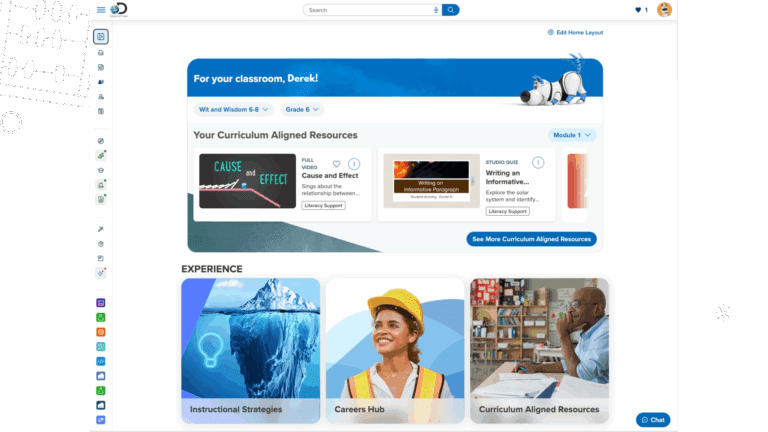Key takeaways
-
Effective instructional strategies help teachers reach all students and improve learning.
-
High-performing classrooms use a wide variety of techniques because students learn in different ways.
-
Teachers have the greatest impact when they intentionally match instructional strategies to student needs.

In today’s classrooms, effective teaching is not defined by a teacher’s personality, charisma, or even experience alone—it’s shaped by the intentional use of instructional strategies that help all students learn.
As a superintendent, I’ve visited countless classrooms across grade levels and districts. The most effective teachers aren’t just delivering content; they are using specific instructional strategies that promote thinking, discussion, practice, reflection, and learning.
Understanding what instructional strategies are—and how to use them proficiently—can transform classroom learning and create an environment where every student has the opportunity to succeed.
What Are Instructional Strategies?
Instructional strategies are methods, techniques, or approaches teachers use to help students learn more effectively. These strategies guide how teachers introduce content, build understanding, check for mastery, and support students as they apply what they have learned.
When people ask, What are instructional strategies?, the simplest answer is this: they are the tools teachers use to make learning more engaging and accessible. These strategies can be whole-class, small-group, or individual. They can also be discussion-based, hands-on, technology-driven, collaborative, or reflective. What makes them “instructional” is the intention behind them—each strategy is chosen with a purpose and aligned to a learning goal.
Instructional strategies also create consistency in the classroom. When students know what to expect—whether it’s modeling, guided practice, or small-group work—they can focus less on the routine and more on the learning. Over time, these predictable structures help students become more confident and independent learners.
Why Instructional Strategies Matter
Schools that focus on effective teaching practices achieve higher levels of student achievement, stronger student engagement, and more predictable classroom environments. In my experience, intentional instructional decision-making strengthens everything from daily interactions to long-term academic outcomes.
Effective instructional strategies matter because they:
- Support all students. Every classroom includes students with varied backgrounds, strengths, and needs. Strategies such as differentiation, modeling, and scaffolding ensure that all students have access to appropriate grade-level content.
- Increase student engagement. When students participate in structured conversations, hands-on tasks, or collaborative problem-solving, they are far more likely to stay engaged. This engagement is not accidental—it is the result of the teacher’s instructional choices.
- Improve understanding and retention. Guided practice, visuals, and quick checks help students learn new ideas and remember them. These strategies make complex tasks easier and better reinforce key concepts.
- Strengthen routines and classroom culture. Consistent use of instructional strategies creates a sense of safety and structure in classrooms. When students know what success looks like—and how to achieve it—behavior improves and classrooms run more smoothly.
- Support Teacher Effectiveness. Strong instructional strategies reduce guesswork. Instead of relying on trial and error, teachers can use proven techniques that reliably increase understanding, engagement, and learning outcomes.
Research consistently shows that thoughtful instructional choices directly influence student achievement. When teachers select strategies that align with learning goals and student needs, academic growth improves, and classroom learning becomes more effective and meaningful.
What Are the Different Types of Instructional Strategies?
While there are countless ways to categorize instructional strategies, most fall within a few broad groups that help teachers decide when and why to use each approach. These include:
Direct Instruction
Direct instruction uses clear, explicit teaching to introduce new skills and ideas. The teacher models the skill, explains their thinking, and guides students through practice.
Examples of direct instruction include: modeling and think-alouds, guided practice, explicit vocabulary instruction, and mini-lessons.
Collaborative Learning
Collaborative learning tasks students with working together to solve problems, develop ideas, and deepen their understanding of a topic.
Examples include: Think-Pair-Share activities, literature circles, and group projects.
Inquiry-Based Learning
These strategies encourage students to explore ideas, ask questions, and discover answers on their own.
Examples of inquiry-based learning include: project-based learning, Socratic seminars, experiments, and research tasks.
Differentiated Instruction
Differentiation helps teachers meet diverse learning needs by adjusting content, tasks, or the way lessons are taught.
Examples include: tiered assignments, flexible grouping, choice boards, and scaffolded texts.
Assessment
While often overlooked, assessment is a critical part of instruction. Teachers use ongoing checks to guide their next steps.
Examples include: exit tickets, conferences, quick writes, and whiteboard responses.
What Are Examples of Instructional Strategies?
Teachers often ask, What are examples of instructional strategies? Here are several high-impact strategies that can be implemented in classrooms today:
- Think-Pair-Share encourages every student to participate by thinking on their own, sharing with a partner, and then discussing with the class.
- Cooperative learning approaches like Jigsaw ensure every student has a role and contributes to group learning.
- Modeling and think-alouds show students the steps needed to approach a task or solve a problem.
- Graphic organizers, such as Venn diagrams and mind maps, help students visualize relationships and organize information.
- Sentence frames support academic discourse and structured writing.
- Centers provide active learning opportunities and allow students to practice skills in multiple ways.
- Retrieval practice strengthens memory and long-term retention.
- Exit tickets provide quick checks for understanding at the end of a lesson.
- Anchor charts offer ongoing visual reference points.
- Digital resources within a high-quality K–12 online learning platform can enhance engagement and support mastery across content areas.
These examples show that strong instructional practice is not about one tool—it’s about selecting the right strategy for the right moment.
What Are the 5 Instructional Strategies?
Schools often define the five instructional strategies by using a common set of five standard approaches:
- Direct Instruction: Explaining, modeling, and guiding practice.
- Indirect Instruction: Learning through observation, inquiry, and connection-making.
- Interactive Instruction: Learning by discussing and working with others.
- Experiential Learning: Learning through hands-on activities and real-world experiences.
- Independent Study: Students working on their own to build skills or explore topics.
How to Choose the Right Strategy for Your Students
Choosing the right instructional strategies is about the teacher’s purpose, not their preferences. The most effective teachers intentionally consider what they want students to learn and select the approach that best supports that goal. When strategy selection becomes purposeful rather than habitual, instruction becomes clearer, more engaging, and more effective.
Start with the Learning Objective
Every strategy begins with a clear destination. Teachers should first identify what students must know or be able to do by the end of the lesson.
If the goal is to introduce new content, direct instruction or modeling may be appropriate. If the goal is application, problem-solving, or discussion, strategies like cooperative learning or inquiry tasks may be a better fit. The approach is successful when it directly supports the outcome you want students to reach.
Consider Student Needs
The students in front of you should shape your instructional choices. Their background knowledge, confidence, and learning preferences all influence which approach will work best.
- Use modeling or guided practice when students need more clarity.
These strategies work well in subjects like math or writing, where students benefit from seeing an expert think through a problem. - Use cooperative learning when students need engagement or peer support.
This is effective in ELA discussions, science labs, and social studies tasks where multiple viewpoints enhance understanding. - Use inquiry tasks when students need deeper thinking and exploration.
Inquiry is ideal for STEM projects, research activities, and hands-on investigations that require questioning and discovery.
Matching the strategy to your students’ needs ensures they can access the lesson.
Use Data
Teachers make better instructional decisions when they use real-time information. Exit tickets, observations, student conversations, and quick formative checks all show you whether students are ready to move on or need more support.
In classrooms where teachers use data effectively, instruction becomes more responsive. Teachers can reteach when necessary, extend learning for students who are ready, and adjust the strategy before students become
Prioritize Consistency
A small set of well-executed strategies is more powerful than a long list used inconsistently. Students thrive when routines feel predictable—when they know how group work operates, what to expect during guided practice, or how reflection time will look.
Consistency doesn’t mean using the same strategy every day; it means using strategies often enough that students understand the structure and can focus on learning rather than directions.
Reflect and Adjust
Reflection strengthens every instructional decision. Effective teachers regularly ask themselves:
- Which students understood the lesson?
- Who needs more support?
- Did the strategy help students reach the goal?
Reflection improves lessons over time and supports continuous growth.
Districts that prioritize these skills often experience higher teacher retention and more effective instructional practice, because teachers feel supported, confident, and prepared with instructional strategies that work.
Effective Instructional Strategies, More Effective Classrooms
Instructional excellence comes from using instructional strategies that meet students where they are and help them build deeper understanding. When teachers focus on what works, check student progress, and adjust as needed, the impact is immediate. Whether improving direct instruction, using collaborative approaches, or relying on formative assessment to guide your next steps, choosing the right instructional strategy can transform a classroom.







